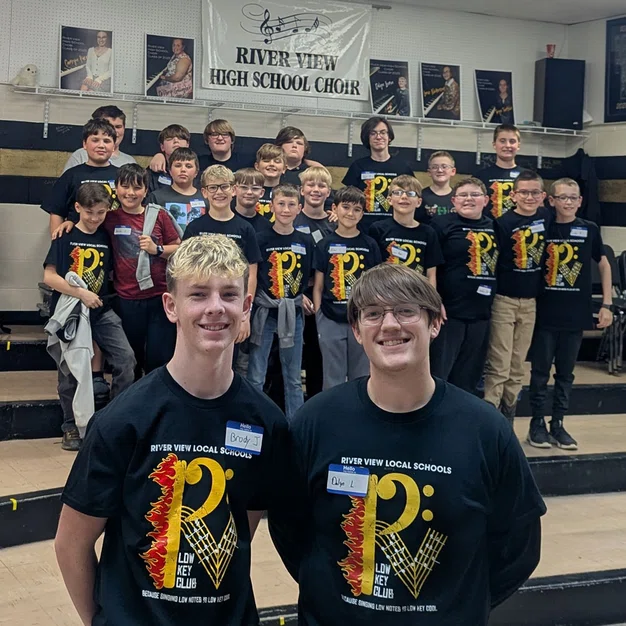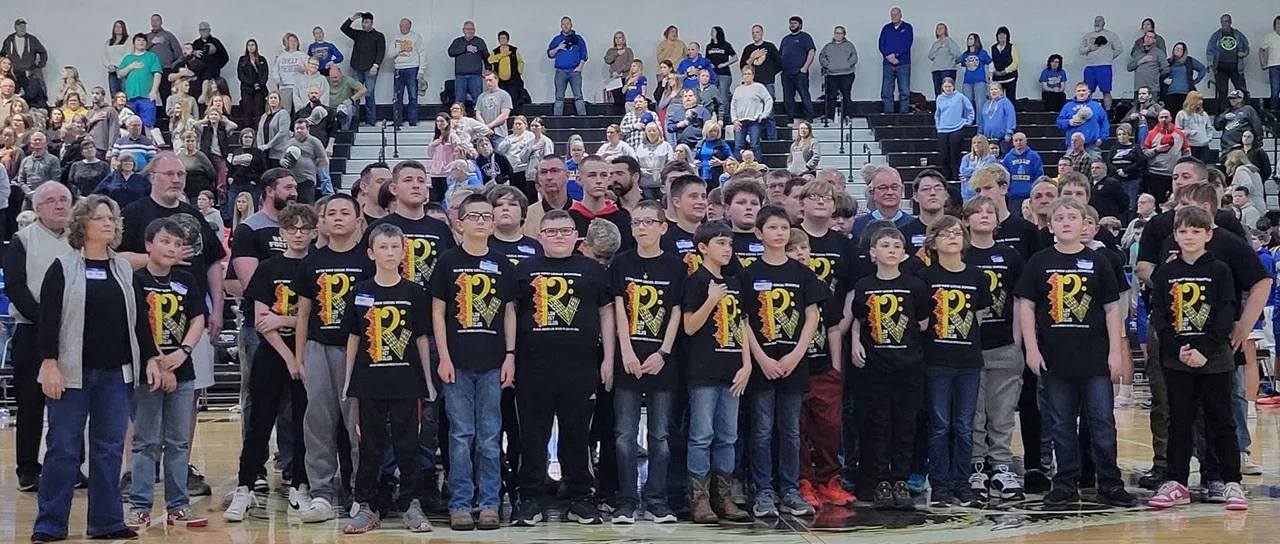©2025 Ohio Music Education Association



“There is nothing new under the sun.” This was the opening statement from my English Lit teacher on the first day of my senior year in high school. It was a statement to spark meaningful dialogue and has resonated over the course of my 20+ years in the classroom in many ways, but most recently in regard to the consideration of the deficit of male participation within my choral ensembles. For the bulk of my career, the problem of limited male participation felt like that achy left knee that was doomed to bother me forever, but after some research, and renewed energy from two enthusiastic male students, this concern would soon become the catalyst for a brand new club in my school district known as the “Low Key Club.”
Since 2016 my high school has encouraged all seniors to participate in a “Senior Project.” Students are required to have an adult mentor and choose a project that will improve their school, themself, or the community. Dalyn, a male senior choir member approached me about investing his time into “normalizing singing for boys.” He felt that many boys (and men) in our community viewed public singing negatively. As both a football player and choir member, he hoped that his diverse interests may foster change. To gain additional leverage, and provide longevity, we recruited Brody, a junior choir member who participated on the soccer, basketball, and track teams. Together, the three of us would devise an action plan for the 2024-2025 school year (and beyond) in hopes of promoting a more positive perception of public singing for males of all ages. While we believed in the end goal, we also needed background information and research to help generate and support our ideas.
The timing seemed too perfect. As a current master’s student with the Voice Study Center, an associate college under The University of Essex, I began research to not only fulfill the requirements of my studies, but also to support and guide the project. Research conducted by John Cooksey (2000), Martin Ashley (2014), and Patrick Freer (2016) were a catalyst for our conversations. Freer, current researcher and vocal pedagogue from The University of Georgia had located over 400 pieces of literature on the interrelationship of men with music. He discovered titles such as “Music and Manliness” from 1902 and a 1923 publication entitled “Why Do Not More Men Take Up Music” (Harrison et al, 2012). I began to realize that unbalanced voicings within the choir due to underrepresented male participation was not “new under the sun,” and it was time to attempt research-based solutions.

After sharing research findings with Dalyn and Brody, we honed in on just a few key topics. Boys gain self-efficacy through spending time with older male singers (Ashley, 2011; Fisher, 2014; Freer, 2016). Considering this information, it was decided we would focus our attention on boys in grades 4-6 (whose school conveniently shared a parking lot with our high school) and partner them with the older high school choir members. Another dive into research indicated that despite boys’ potential dislike of participating in a choir, they do like to sing (Freer, 2012). We decided to capitalize on this fact and sing familiar songs to keep the atmosphere “low key” but with the understanding that the night would end with a performance of the National Anthem at a home varsity basketball game. In a small town, what could be more appealing on a cold January night?
Little by little, more ideas were brought to the table. Dalyn and Brody decided that a t-shirt may generate additional interest amongst the young boys also providing a branding opportunity to support the club name. The concept of a unique t-shirt aligns with the theory of Possible Self, which is a link between cognition and motivation, and helps to define what or who a person wants to become (Jackson and Tome, 1993; Tomova et al, 2021), essentially helping to align one’s social identity. (Oyserman et al, 2006, Szabo, 1999). Dalyn and Brody collaborated with a fellow choir member and artist, who created a design that utilized both music symbols and aspects of our school initials and colors. Graciously, our local music booster organization agreed to fully financially support the event-including the t-shirts.
Soon after the holiday rush was over, a social media campaign commenced, inviting men of all ages to join us in the singing of the National Anthem. I had no idea how many men would join us. When the day finally arrived, 40 boys in grades 4-6, escorted by their building principal, descended on the high school music department. Fortunately, members of our local Tri-M Honor Society graciously assisted with crowd control while our young singers enjoyed relay games, a tour of the high school, lots of pizza, karaoke singing, and a lesson on The Star Spangled Banner, which was quickly followed by a full rehearsal with our adult male singers. To my delight, joining us in singing was our superintendent, principal, student resource officer, football coach, teachers, bus drivers, retired teaching staff, and of course members from our own choir. It was an amazing experience, and especially thrilling to see smiling boys and men of all ages singing our National Anthem together on the basketball court, essentially confirming the research right before our eyes.
We were able to organize two additional “Low Key Club” meetings last year but they didn’t include a public performance. As the club’s name suggests, we kept the meetings low key and played games, ate snacks, and sang songs together just for fun. Our community continued to support the endeavor by donating all of the snacks. I will probably always work hard to keep boys singing in the choir, but at least the work can be rewarding when there is collaboration and shared vision. I am hopeful that the Low Key Club will continue to meet, because this year’s rosters in fact show an increase in male participation. (Whew!)
References
Ashley, M., 2011. The angel enigma: experienced boy singers' perceptual judgements of changing voices. Music Education Research, 13(3), pp.343-354.
Ashley, M., 2014. Contemporary choral work with boys. Compton Publishing, St. Giles, Oxford.
Cooksey, J., 2000. Voice transformation in male adolescents. Bodymind and voice: Foundations of lifespan voice education. Iowa: National Center for Voice and Speech.
Fisher, R., 2009. British and American theories of the changing male voice: An historical overview. Journal of Historical Research in Music Education, 31(1), pp.37-47.
Freer, P.K., 2012. From boys to men: Male choral singing in the United States. Perspectives on males and singing, pp.13-25.
Freer, P.K., 2016. The changing voices of male choristers: an enigma… to them. Music Education Research, 18(1), pp.74-90.
Harrison, S.D., Welch, G.F. and Adler, A., 2012. Men, boys and singing. Perspectives on males and singing, pp.3-12.
Jackson, S. and Tomé, H.J.R. eds., 1993. Adolescence and its social worlds. Psychology Press.
Oyserman, D., Bybee, D. and Terry, K., 2006. Possible selves and academic outcomes: How and when possible selves impel action. Journal of personality and social psychology, 91(1), p.188.
Szabo, M., 1999. Why Don't Boys Sing?. General Music Today, 12(2), pp.11-14.
Tomova, L., Andrews, J.L. and Blakemore, S.J., 2021. The importance of belonging and the avoidance of social risk taking in adolescence. Developmental Review, 61, p.100981.

Dawn Anglin has served as the choral director for grades 7-12 at River View High School in Warsaw, Ohio for the past 21 years. She is the local Tri-M Honor Society advisor, and is currently working on a Masters of Vocal Pedagogy from the Voice Study Center, an associate college of the University of Essex.




